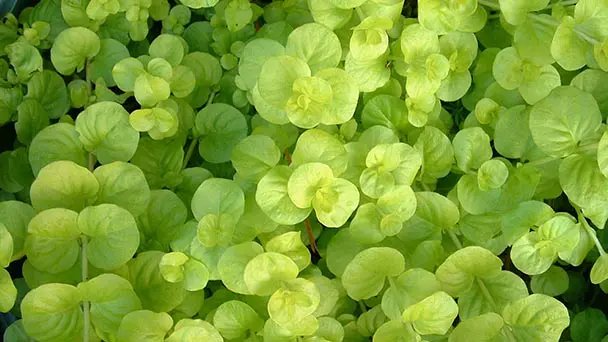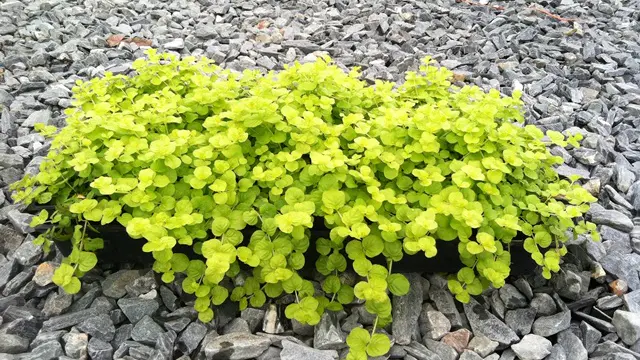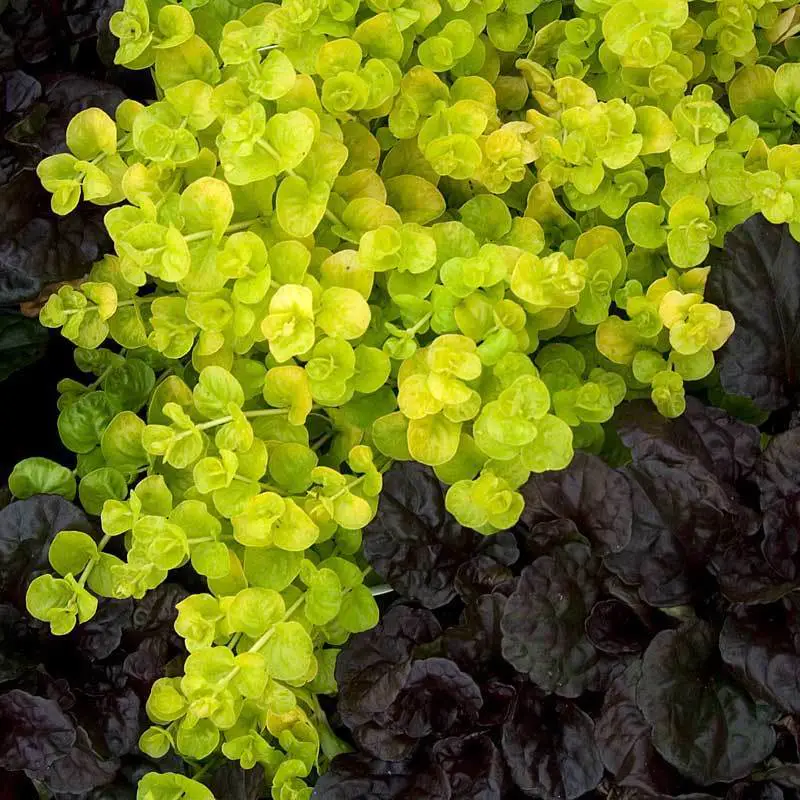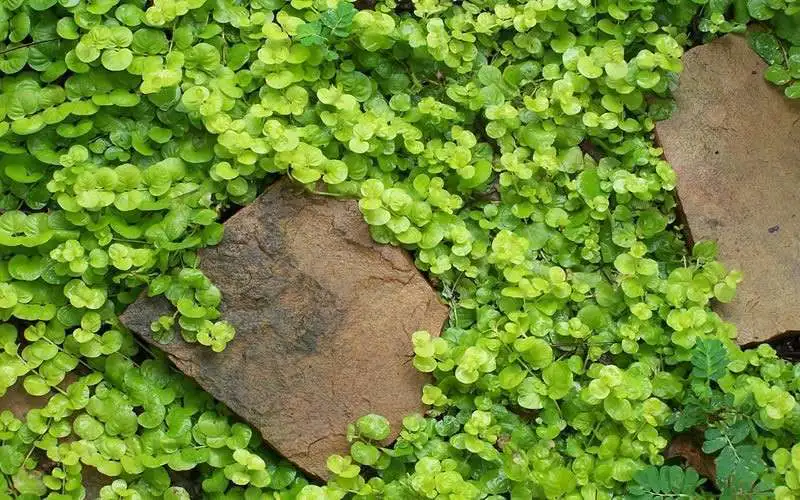Creeping Jenny Profile - Grow and Care for Lysimachia Nummularia
Written by Ivy
Jan 03 2023

Creeping Jenny (Lysimachia Nummularia) is a small perennial creeping herb of Primulaceae, belonging to the order of tubular flowers and Primulaceae. Creeping Jenny has kidney shaped to round leaves, with a diameter of 4-25 mm. The flowers are solitary in leaf axils, and the petiole is shorter than the petiole, filiform. Creeping Jenny has green leaves and small yellow flowers. How to breed Creeping Jenny? In fact, it's easy to breed Creeping Jenny. As long as we water more and pay attention to the shade environment, they can grow well.


It's very convenient for Creeping Jenny to prune the branches to the same height. First, it's necessary to pinch the excessively high branches, so that the excessively high branches of Pennisetum will be flush with the low branches, which is conducive to beauty and growth. When you pinch the branches of Creeping Jenny, don't throw away the remaining branches. You can choose another flower pot for cutting to survive. When the plants pinched are at the same height, Another pot of Creeping Jenny has already survived and needs to be trimmed.
Except in the cold season, everyone can prune in Creeping Jenny pruning. Then, in the process of Creeping Jenny pruning, we should try to avoid that the branches of Creeping Jenny are too high, and they don't look good when there are no leaves. Finally, when pruning, you can prune according to your favorite shape.
When creeping Jenny repotting, we need to pour out the Lysimachia christinae together with the soil inside. Then remove the soil on the root, and then treat the root. Cut the thick roots and trim the long roots of Creeping Jenny. Because a lot of Lysimachia christinae grow together, if there is withered, it needs to be removed completely.
Before putting on the pot, we should lay a layer of coarse sand or ceramsite on the bottom of the pot, and then lay a layer of nutrient soil. After putting the Lysimachia christinae on it, add water appropriately and fix the plant. Then place it in a cool and ventilated environment for maintenance. Increase the light fully. After it recovers its growth, it can be maintained daily.
Before creating Jenny propagation from cutting, we should first select cuttings, select well-growing Lysimachia Plants, and cut strong branches without diseases and pests from above to ensure that there are 3-4 stem nodes on each section and leaves are reserved at the top. The survival rate of such branches should be high.
Then we can insert the clipped creeping jenny cuttings into the matrix, with a depth of about 3cm, without inserting too deep.
Before we prepare to sow Creeping Jenny, we must soak seeds and promote germination, which can greatly improve the emergence rate. Put the seeds into a container and pour an appropriate amount of water to cover them. If the temperature is not high, wrap them with plastic wrap for insulation. Often change the water and put it in a cool and ventilated place. Generally, it can germinate after a few days.
Creeping Jenny propagation from seed mostly uses loose and fertile soil. Although plants do not have strict requirements for soil, good permeability is very helpful for root respiration and can also prevent ponding. It is generally prepared by mixing 5 parts of rotten leaf soil, 2 parts of garden soil and 2 parts of river mud, which can also provide nutrients for plants, and the slightly acidic environment is also conducive to development.
After preparing basin soil, you can create Jenny propagation from seed. We can sprinkle creeping jenny seeds on the soil surface, cover it with a layer of fine soil, and water it properly to keep it moist. After sowing, it should be placed in the semi shade to avoid light. At the same time, it should ensure good ventilation. After germination, it can appropriately increase the light. In addition, it should be properly fertilized.
Read More:
How to Propagate Creeping Jenny
Creeping Jenny Quick InfoWhen to Plant Creeping JennyWhen does Creeping Jenny Bloom & HarvestCreeping Jenny Care in DetailCreeping Jenny WateringCreeping Jenny SoilCreeping Jenny LightCreeping Jenny TemperatureCreeping Jenny HumidityCreeping Jenny FertilizerCreeping Jenny PruningCreeping Jenny RepottingCreeping Jenny Pest & Disease ControlCreeping Jenny PropagationCreeping Jenny Propagation from CuttingCreeping Jenny Propagation from SeedCreeping Jenny BenefitsThe role of Creeping Jenny in stone removalAnti inflammatory effect of Creeping JennyCreeping Jenny's taboo to drink in water
Creeping Jenny Quick Info
| Botanical/Scientific Name | Lysimachia Nummularia |
| Common Name | Moneywort, Creeping Jenny |
| When to Grow/Bloom/Harvest | Planting in early spring |
| Uses | An infusion is used to treat internal bleeding and diarrhoea |
| Origin | Europe |
| Light Care | Full sun to partial shade |
| Soil Care | Consistently moist, but not soggy soil |
| Temperature Care | 55 to 75 F |
| Humidity Care | Moisture |
| Watering | Water deeply when the soil is just becoming dry |
| Pruning Care | Feel free to cut back |
| Fertilizer Care | Balanced fertilizer each spring |
| Propagation | Seeds and rhizomes |
| Toxic | No toxic effects reported |
| Flower Color | Bright, small yellow flowers |

When to Plant Creeping Jenny
Creeping Jenny is usually planted in spring, usually from March to May. Before sowing, we can soak the seeds in water to promote germination and wrap them with fresh-keeping film. After germination, we need to prepare loose and fertile soil. We can sow Creeping Jenny seeds into it, cover it with a layer of fine soil and water it properly. After that, we should keep good ventilation and add a little light after creeping jenny sprouts.When does Creeping Jenny Bloom & Harvest
Creeping Jenny will bloom from May to July. Creeping Jenny's flowers are yellow and are radial bell shaped. The flowers of Creeping Jenny are very small, with a length of 7-15mm. Flowers are solitary and have pedicels with a length of 1-5cm. The length of pedicels generally does not exceed the length of leaves.Creeping Jenny Care in Detail
Creeping Jenny Watering
The most important thing in breeding Jenny is watering. The water demand of Creeping Jenny is very large. It needs to be watered once in 1 ~ 2 days in spring and autumn. Creeping Jenny has many and dense leaves. It needs to be watered every day in summer to ensure that the basin soil is wet. We also need to spray water on the leaves often. However, in winter, the watering interval of Creeping Jenny should be slightly longer. Water once every 3 ~ 4 days. Do not accumulate water, which will cause root rot.Creeping Jenny Soil
Creeping Jenny has really low requirements for soil. It just needs to keep it loose, breathable and permeable. Even the slightly barren soil can survive. It is necessary to maintain the moisture of creeping Jenny's soil and pay attention not to ponding in the soil. We'd better use a sufficient amount of rotten leaf soil, river mud and an appropriate amount of garden soil in the ratio of 5:2:2 to fully maintain the nutrition of Creeping Jenny.
Creeping Jenny Light
Creeping Jenny likes a humid growth environment, and it is best to put it in a semi cloudy environment. We must not let Creeping Jenny shine directly in the sun, but the completely cool environment will also rot the Lysimachia Plants. We also need to ensure that lysimachia christinae is illuminated by astigmatism for 4 ~ 6 hours every day, so that Creeping Jenny can grow densely and vigorously.Creeping Jenny Temperature
Creeping Jenny is most suitable to grow in a relatively warm environment of 10 ~ 25 ℃. If the summer weather temperature is higher than 33 ℃, it should be placed in a slightly cooler place, otherwise Creeping Jenny will stop growing. If the temperature is lower than 5 ℃ in winter, corresponding heat preservation measures shall be taken to avoid plant freezing.Creeping Jenny Humidity
Creeping Jenny's growth environment needs to use media with good water retention and often moisturize. Amphibious creeping Jenny is common in aquatic ponds, wetlands and other spaces, and water pans and aquariums are also suitable. Creeping Jenny likes warm and humid environment, but she is not resistant to cold.Creeping Jenny Fertilizer
Creeping Jenny usually grows very thickly. Such growth needs fertilizer. We must pay attention to fertilizing Creeping Jenny in time. At least in spring, we need to apply fertilizer once every 15 ~ 20 days. In autumn, we also need to apply appropriate topdressing, twice is the best.Creeping Jenny Pruning
In the first step of pruning Jenny pruning, the weak branches, rotten branches and branches with poor growth should be spared as much as possible, which is also convenient for pinching and cutting later.It's very convenient for Creeping Jenny to prune the branches to the same height. First, it's necessary to pinch the excessively high branches, so that the excessively high branches of Pennisetum will be flush with the low branches, which is conducive to beauty and growth. When you pinch the branches of Creeping Jenny, don't throw away the remaining branches. You can choose another flower pot for cutting to survive. When the plants pinched are at the same height, Another pot of Creeping Jenny has already survived and needs to be trimmed.
Except in the cold season, everyone can prune in Creeping Jenny pruning. Then, in the process of Creeping Jenny pruning, we should try to avoid that the branches of Creeping Jenny are too high, and they don't look good when there are no leaves. Finally, when pruning, you can prune according to your favorite shape.
Creeping Jenny Repotting
Before we give creeping Jenny repotting, we should first prepare new pot soil, and the flower pot should use a pot with a water outlet at the bottom. Because Creeping Jenny needs a lot of water, if there is no water outlet at the bottom of the flowerpot, it will affect the circulation of water, which is very deteriorated and affect the growth of Creeping Jenny. The soil can be mixed with humus, garden soil and mountain mud, and a small amount of rotten fertilizer can be added.When creeping Jenny repotting, we need to pour out the Lysimachia christinae together with the soil inside. Then remove the soil on the root, and then treat the root. Cut the thick roots and trim the long roots of Creeping Jenny. Because a lot of Lysimachia christinae grow together, if there is withered, it needs to be removed completely.
Before putting on the pot, we should lay a layer of coarse sand or ceramsite on the bottom of the pot, and then lay a layer of nutrient soil. After putting the Lysimachia christinae on it, add water appropriately and fix the plant. Then place it in a cool and ventilated environment for maintenance. Increase the light fully. After it recovers its growth, it can be maintained daily.
Creeping Jenny Pest & Disease Control
Creeping Jenny rarely gets sick, but sometimes clams, worms and snails may eat stems and leaves. If this phenomenon occurs, we usually use 90% crystal trichlorfon for 1000 times dilution before watering. 8% miechuanling granules or 10% paraacetaldehyde granules can also be used to remove insects from Creeping Jenny in a sunny evening.
Read More:
How to grow and care for creeping Jenny
How to grow and care for creeping Jenny
Creeping Jenny Propagation
Creeping Jenny Propagation from Cutting
Creeping Jenny can carry out cutting propagation. Because the seeds are small and difficult to collect, creeping Jenny propagation from cutting is a common propagation method. The cutting operation is relatively simple and the survival rate is also very high. There is no too much limit on the time. Cutting can be carried out all year round. However, the best time is in spring and autumn, and the temperature is appropriate, which is good for the survival and growth in the later stage. It can also be carried out in other seasons, but pay attention to avoid summer noon.Before creating Jenny propagation from cutting, we should first select cuttings, select well-growing Lysimachia Plants, and cut strong branches without diseases and pests from above to ensure that there are 3-4 stem nodes on each section and leaves are reserved at the top. The survival rate of such branches should be high.
Then we can insert the clipped creeping jenny cuttings into the matrix, with a depth of about 3cm, without inserting too deep.
Creeping Jenny Propagation from Seed
Creating Jenny propagation from seed is generally in spring, usually from March to May. The climate at this time is relatively warm, which is very suitable for seed rooting and seedling growth. If it is in summer, high temperature and light can easily lead to sunburn, so it should not be carried out. Autumn planting has to face the problem of overwintering, and the growth of seedlings is easy to be affected.Before we prepare to sow Creeping Jenny, we must soak seeds and promote germination, which can greatly improve the emergence rate. Put the seeds into a container and pour an appropriate amount of water to cover them. If the temperature is not high, wrap them with plastic wrap for insulation. Often change the water and put it in a cool and ventilated place. Generally, it can germinate after a few days.
Creeping Jenny propagation from seed mostly uses loose and fertile soil. Although plants do not have strict requirements for soil, good permeability is very helpful for root respiration and can also prevent ponding. It is generally prepared by mixing 5 parts of rotten leaf soil, 2 parts of garden soil and 2 parts of river mud, which can also provide nutrients for plants, and the slightly acidic environment is also conducive to development.
After preparing basin soil, you can create Jenny propagation from seed. We can sprinkle creeping jenny seeds on the soil surface, cover it with a layer of fine soil, and water it properly to keep it moist. After sowing, it should be placed in the semi shade to avoid light. At the same time, it should ensure good ventilation. After germination, it can appropriately increase the light. In addition, it should be properly fertilized.
Read More:
How to Propagate Creeping Jenny
Creeping Jenny Benefits
The role of Creeping Jenny in stone removal
Creeping Jenny has the effects of propagation gallbladder and stone excretion and diuresis and stone excretion. The polysaccharide component in the alcohol insoluble matter of Creeping Jenny can inhibit the crystal growth of calcium oxalate monohydrate, and the inhibition increases with the increase of concentration. The inhibition of normal human urine on the crystal growth of calcium oxalate monohydrate.Anti inflammatory effect of Creeping Jenny
Intraperitoneal injection of Creeping Jenny 50g/kg and its total flavonoids and phenolic acids 3.75g/kg significantly inhibited the increase of vascular permeability in mice caused by histamine, the ear inflammation in mice caused by croton oil, and the ankle joint swelling in rats and cotton ball granuloma in rats caused by egg white injection.Creeping Jenny's taboo to drink in water
Creeping Jenny is a traditional Chinese medicine. It not only has the effect of preventing and treating stones, but also can promote water, relieve gonorrhea, reduce swelling and inflammation. However, Creeping Jenny can't take it for a long time, because if you take Lysimachia christinae for a long time, it is easy to damage the healthy qi of the body, which will greatly reduce the effect on the treatment of kidney stones or gallstones, and even the stones may be more serious.Latest Updated
- Benefits of Bugleweed - 7 Science-backed Health Benefits
- Bugleweed Dangers & Side Effects - Is It Poisonous?
- How to Plant Evergreen Trees - What You Should Know
- When to Plant Evergreens - Grow Guide for Evergreen Trees
- 12 Wonderful Evergreen Shrubs for Your Garden
- 12 Popular Evergreen Plants with Pictures for Beginners
- When And How To Prune A Lilac Bush Like a Pro
- How to Grow & Care for Lilac Vine (Hardenbergia Violacea)
- Japanese Lilac Tree (Syringa Reticulata) Care & Propagation Guide
- Shumard Oak Pros and Cons - What to Know
Popular Articles
- Winter maintenance of Antirrhinum Majus
- How to Grow Terminalia Mantaly Tree
- How to Grow and Care for Crossostephium Chinense
- How to grow Antirrhinum Majus in spring
- Peristeria Elata (Dove Orchid) Profile: Info & Care Guide
- Underwatered Snake Plant (Sansevieria Trifasciata) - Signs And How To Fix
- How to Care for Brazilian Jasmine Plant (Mandevilla Sanderi)
- How to Grow & Care for Graptopetalum Purple Delight in Summer
- Rosa Chinensis (China Rose): Plant Growing & Care Tips
- How to Care for Baby Sun Rose (Aptenia Cordifolia)